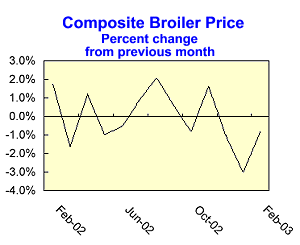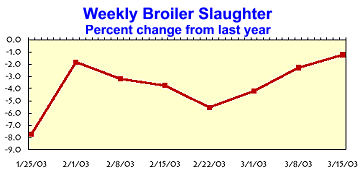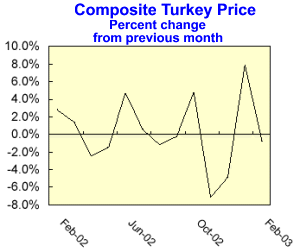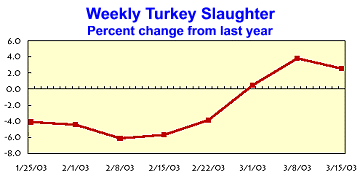



Poultry Outlook Report - March 2003
By U.S.D.A., Economic Research Service - This article is an extract from the March 2003: Livestock, Dairy and Poultry Outlook Report, highlighting Global Poultry Industry data. Broiler production in 2003 is expected to be just barely above 2002 while turkey production is expected to be down less than 1 percent from last year.| Overview |

Broiler production in 2003 is expected to be about 32.3 billion pounds, just barely above
2002. Broiler production has increased each year since 1975. Weekly chick placements
continue to run below a year ago in response to low prices last fall and continuing trade
uncertainties. Turkey production is expected to total about 5.7 billion pounds, down less
than 1 percent from last year.
In 9 of the last 11 months, the number of poults placed for growout has been below the level of the same month the previous year.
| Broiler Production Down in January, Lower Production Expected in 2003 |
 Broiler production for January 2003 was estimated at 2.748 billion pounds, down 1.1 percent from the previous year. With weekly chick placements continuing to be lower than the previous year, the forecast for broiler production in the first quarter of 2003 is now 7.725 billion pounds, 1.2 percent down from the previous year.
Broiler production for January 2003 was estimated at 2.748 billion pounds, down 1.1 percent from the previous year. With weekly chick placements continuing to be lower than the previous year, the forecast for broiler production in the first quarter of 2003 is now 7.725 billion pounds, 1.2 percent down from the previous year.
The estimates for the second and third quarters have also been lowered to 8.200 billion pounds, making the overall estimate for 2003, 32.325 billion pounds, just barely above 2002. This is the smallest increase in broiler production since 1973. Revisions in broiler production contained in the Poultry Slaughter Annual Summary for 2002 lowered total broiler production for 2002, to 32.240 billion pounds, up 3.1 percent from 2001. The increase is the result of a 1.7-percent increase in the number of broilers slaughtered and a 1.6-percent increase in the average weight at slaughter.
One of the results of falling broiler production has been gradually increasing prices for some broiler products at both the wholesale and retail levels. Over the first 2 months of 2003, the 12–city whole broiler price has averaged 60.5 cents a pound, 7.2 percent higher than during the same time in 2002.
Prices have also risen for breast meat products. Prices for boneless-skinless breasts in the Northeast market averaged 135.8 cents a pound during January and February, about 13 percent higher than the previous year.

Prices for rib-on breasts averaged 83.5 cents a pound, up 37 percent from the same time in 2002. These prices have risen the most because these products are sold primarily in the domestic market. Prices for other broiler products that are more dependent on the export market, while moving higher during January and February are still below their year-earlier levels. Leg quarter prices averaged 20 cents a pound, up significantly from their average price over the second-half of 2002, but still below where they were at the start of 2002. The same pattern can be seen for wings, thighs and drumsticks, which have increased since the end of 2002, but still remain below a year earlier. With a forecast of lower production through the first three-quarters of 2003, domestic broiler prices are expected to strengthen further, given no additional disease outbreaks or disruptions to broiler exports.
| Disease Issues Continue To Affect Poultry Industry |
Disease outbreaks continue to cloud the outlook for the domestic industry both in terms of lower production and lost export opportunities. The outbreak of Exotic Newcastle Disease (END) in the West has continued to spread with smaller outbreaks in Arizona. However, no new END
cases have been reported in California, the State that has been most severely affected by the
outbreak.
The latest disease problem has been in Connecticut where officials have placed some egg laying operations under quarantine as they test to see if the birds have been infected with Avian Influenza (AI). The AI outbreak in Connecticut is expected to be of the low-pathogenic variety. In response to the reports of the outbreak in Connecticut, importing countries such as Japan and Korea have placed a temporary ban on the importation of poultry and egg products from the United States.
The ban placed on imports of U.S. poultry and egg products will likely remain in place until the Japanese and Korean Governments are given information by APHIS on the extent and severity of the outbreak. As of March 12, Japan has lifted its ban on all U.S. poultry products, but the ban on products from Connecticut remain in effect.
The United States is not alone in dealing with poultry disease outbreaks. Presently the Netherlands is dealing with an outbreak of high-pathogenic AI in broiler flocks. The Netherlands is one of the largest broiler producers in the EU. Some countries normally importing from the Netherlands are likely to restrict imports until the extent of the outbreak is known.
| Turkey Production Seen Down in 2003 |
 Turkey production in 2003 is forecast at 5.675 billion pounds, down less than 50 million pounds
or 0.7 percent lower than the previous year. With beginning stocks up considerably from the previous year and limited growth expected in exports, turkey prices are expected to be relatively flat in 2003, especially for turkey parts.
Turkey production in 2003 is forecast at 5.675 billion pounds, down less than 50 million pounds
or 0.7 percent lower than the previous year. With beginning stocks up considerably from the previous year and limited growth expected in exports, turkey prices are expected to be relatively flat in 2003, especially for turkey parts.
In 9 of the last 11 months, the number of poults placed for growout has been below the level of the same month the previous year. The lower poult placements during most of 2002 are expected to result in lower turkey production in the first two quarters of 2003. While beginning stocks in 2003 for turkey parts were 68 percent higher than in the previous year, stocks of whole birds at the start of 2003 were down 10 percent. The smaller stocks for whole birds and the lower production has pushed the 3-region average price for whole birds higher in January and February, after being lower on a year-over-year basis for the previous 20 months.
Revisions in turkey production lowered 2002 production to 5.713 billion, down slightly from the earlier estimate and 2.7 percent higher than the previous year. Like broilers, the increase in turkey production was a result of both higher numbers of birds going to slaughter (up 0.7 percent) and an increase in their average weight (up 2.5 percent).

| Further information |
Links
For more information view the full Livestock, Dairy and Poultry Outlook - March 2003 (pdf)Source: Livestock, Dairy and Poultry Outlook - U.S. Department of Agriculture, Economic Research Service - March, 2003








